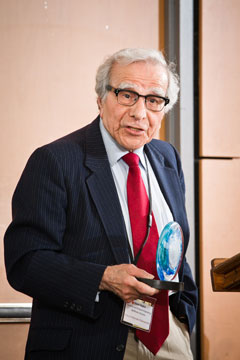I. First Special Issue on Cognitive Dynamic Systems
Published by Proc. IEEE (download the table of contents).
II. COLLABORATIVE WORK WITH INDUSTRY
1. White paper on Cognitive Radar Information Networks for security along the Great Lakes, Collaborator: Accipiter Radar Technology.
III. BOOKS
1. S. Haykin, Adaptive Filter Theory, 5th Edition, Prentice Hall, 2013.
2. S. Haykin, Digital Communication Systems, John Wiley and Sons, 2013.
3. S. Haykin, Cognitive Dynamic Systems, Cambridge Univerity Press, March 2012. (The first book written on this integrative new field.)
IV. PAPERS
1. S. Haykin and J.M. Fuster, On Cognitive Dynamic Systems: Cognitive Neuroscience and Engineering Learning From Each Other, Proc. IEEE, Special Issue on Cognitive Dynamic Systems, April 2014.
2. A. Amiri and S. Haykin, Improved Sparse Coding under the Influence of Perceptual Attention, Neural Computation Journal, MIT-Press, February 2014.
3. S. Haykin and P. Setoodeh, Cognitive Radio Networks: The Supply Chain Paradigm, second revision.
4. F. Khozeimeh and S. Haykin, Self-organized Dynamic Spectrum Management for Ad Hoc Networks, IEEE Trans. on Wireless Communications, under review.
5. S. Haykin, Y. Xue, and P. Setoodeh, "Cogitive Radar: Step Toward Bridging Gap Between Neuroscience and Engineering," Proc. IEEE, 2012, to be published.
6. S. Haykin, M. Fatemi, Y. Xue, and P. Setoodeh, "Cognitive Control," Proc. IEEE, submitted.
7. M. Fatemi and S. Haykin, "On Reinforcement Learning and Planning in Cognitive Control", IEEE Trans. on Neural Networks and Learning Systems.
8. P. Setoodeh and S. Haykin, “Double-layer dynamics of cognitive radio networks,” The First IEEE International Workshop on Emerging COgnitive Radio Applications and aLgorithms (CORAL), San Francisco, June 2012.
9. P. Setoodeh and S. Haykin, “Dynamic spectrum supply chain model for cognitive radio networks,” The First IEEE International Workshop on Emerging COgnitive Radio Applications and aLgorithms (CORAL), San Francisco, June 2012.
V. INVITED LECTURES
1. S. Haykin, "Cognitive Dynamic Systems: Cognitive Control," 2nd International Symposium on Innovative Mathematical Modeling, University of Tokyo, Japan, May 15, 2012.
2. S. Haykin, "Cognitive Control," RIKEN Institute, Tokyo, Japan, May 21, 2012
Opening for New Doctoral Students
We are in the process of expanding our research program under the umbrella of Cognitive Dynamic Systems: Specifically, we are seeking two new Ph.D. students, starting in September 1, 2014, who are expected:
- To develop a passion for working in challenging areas of the exciting integrative field of Cognitive Dynamic Systems.
- To work as a member of a new research team.
The topics to be covered by this new team will address the following:
- a) Probabilistic Reasoning Machine for reciprocally coupling the perceptor and controller of a Cognitive Dynamic System, emphasizing overall system stability.
- b) Expansion of the Cognitive Controller by adding pre-adaptive learning machine for risk control.
- c) Implementation of a two- or three-layered Cognitive Dynamic System with Cognitive Radar for the experimental study, which includes a) and b) in a non-stationary and non-Gaussian environment.
Welcome to Cognitive Dynamic Systems:
Innovative Mathematical Modeling for Practical Applications
Research into Cognitive Dynamic Systems (CDS) in the CSL has been going for over six to seven years, during which time we have made signicant contributions to Cognitive Radio and Cognitive Radar. In the last six months, we have broadened our research interest in Cognitive Control. Last but by no means least, the research program into CDS also includes the application of cognition to the cocktail party problem, work on which is carried out in collaboration wih the University of Sherbrooke, Québec.
To elborate on the essence of the research program into CDS, exemplified by the projects just described, the objective is to learn from cognitive neuroscience novel ideas so as to make a difference in their engineering applications. Looking back on the works done in this integrative field, it can be justifiably said that what we now know about cognitive radar, cognitive control, and cognitive radio, is much deeper than how it was six years ago.
By the same token, we are confident that in the next six years, our knowledge into cognitive dynamic systems will be not only productive but also much richer in depth as well as breadth than it is today.
Historical Notes on Cognitive Dynamic Systems at the Cognitive Systems Laboratory at McMaster University
 |
|
| Picture taken on the occasion of Simon Haykin receiving the Lifetime Innovator Award |
Simon Haykin is Distinguished University Professor at McMaster University. For much of the past ten years he has focused his research effort to how to learn form the human brain and apply it to a new generation of Cognitive Dynamic Systems, exemplified by the following:
1. Cognitive radio, on which the first journal paper, entitled "Cognitive Radio: Brain Empowered Wireless Communications", was published in the IEEE Journal on Selected Areas in Communications (JSAC)., February 2005.
2. Cognitive radar, on which the first journal paper, entitled "Cognitive Radar: A way of the Future", was published in the IEEE Journal on Signal Processing. January 2006. The forthcoming paper, entitled "Cognitive Radar: Step Toward Bridging Gap Between Neuroscience and Engineering", will be published in the IEEE Proceedings, November 2012.
3. In the last few months of 2011, the notion of the "two-state model" was discovered for the first time, with one state representing a target state; and the other state, named the "entropic state", representing environmental uncertainties and disturbances. This new notion opened the way to formulate the basics of Cognitive Control, in the implementation of which use was made of reinforcement learning for the first time ever. A white paper on Cognitive Control was submitted to the IEEE Proceedings few months ago.
4. In November 2006, a point-of-view article in the Proc. IEEE was published, describing the new integrative field of "Cognitive Dynamic Systems." A follow-up to the that first article will be published in the Proc. IEEE, July 2012.
5. Perhaps the biggest look to the future developed in the course of a four-month collaborative work with Dr. Tim Nohara, President of Accipiter Radar Technologies, Fonthill, Ontario. In the White Paper, entitled "Cognitive Radar Information Networks", ideas were described for the first time ever, addressing the issue of security across the Great Lakes in North America by exploiting the information-processing power of cognition
6. Last but by no means least, the first book, entitled "Cognitive Dynamic Systems," was published by Cambridge University Press, in March 2012.
In light of what has been described here, working in collaboration with a gifted and dedicated research group of graduate students and post-doctoral fellows, it can be justifiably said that at the Cognitive Systems Laboratory, McMaster University, we have taken steps aimed at harnessing the information processing power of the human brain for building a new generation of engineering systems. This joint effort has been truly exciting.
 Cognitive
Systems Laboratory (CRL building, Room 107)
Cognitive
Systems Laboratory (CRL building, Room 107)Department of Electrical and Computer Engineering
1280 Main Street West
Hamilton, Ontario
L8S 4K1
Telephone: (905)525-9140 ext. 27282
